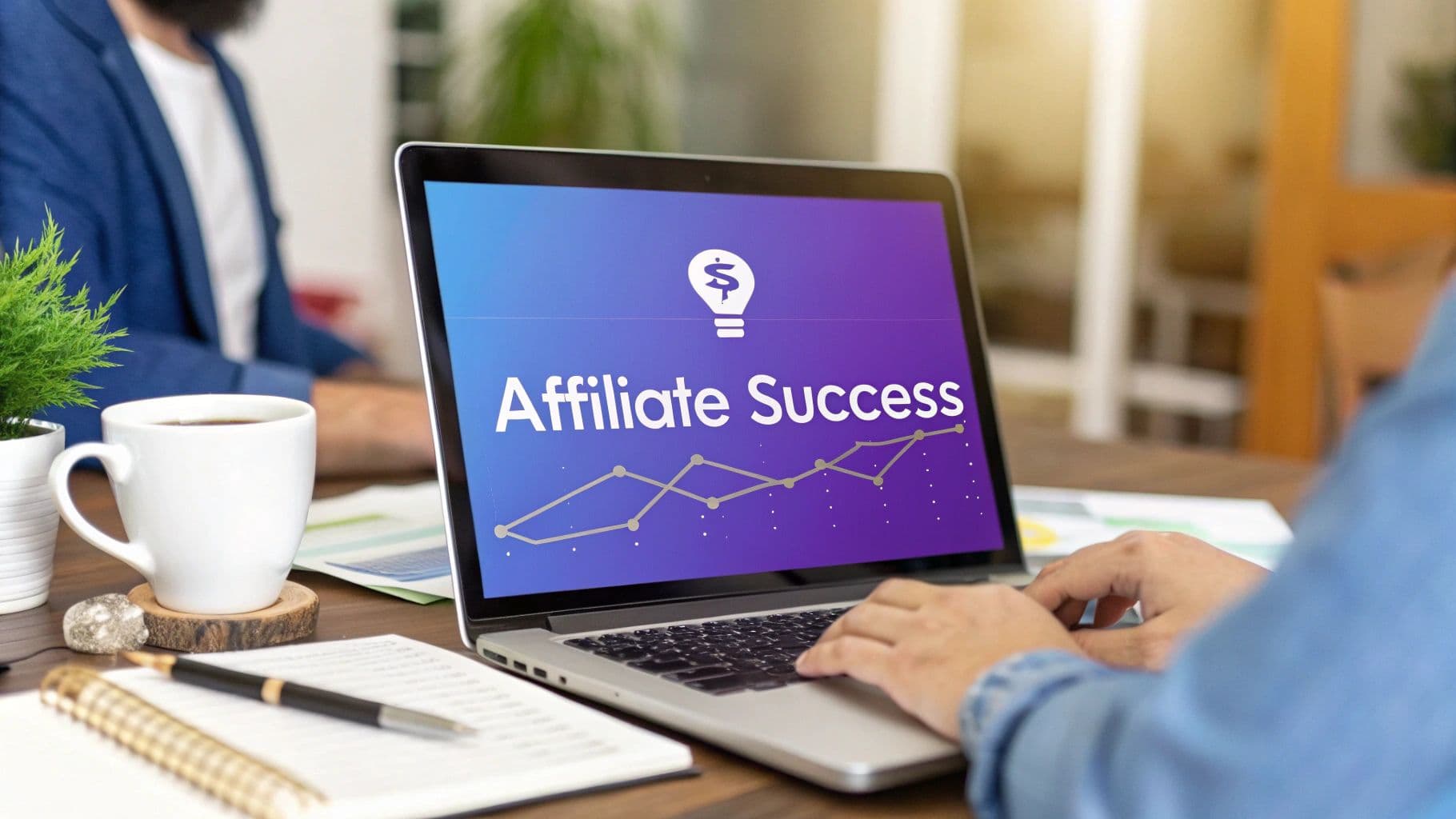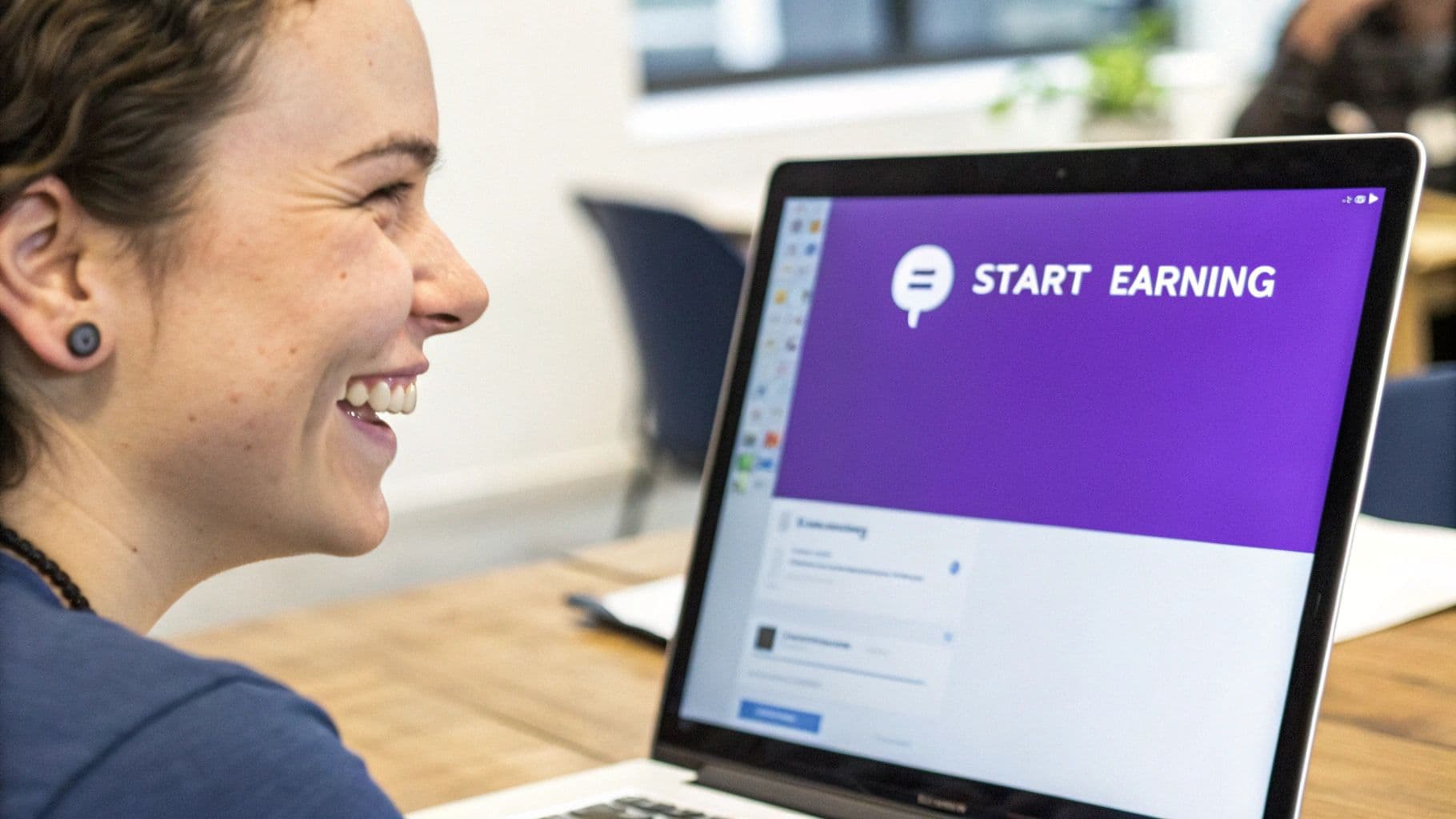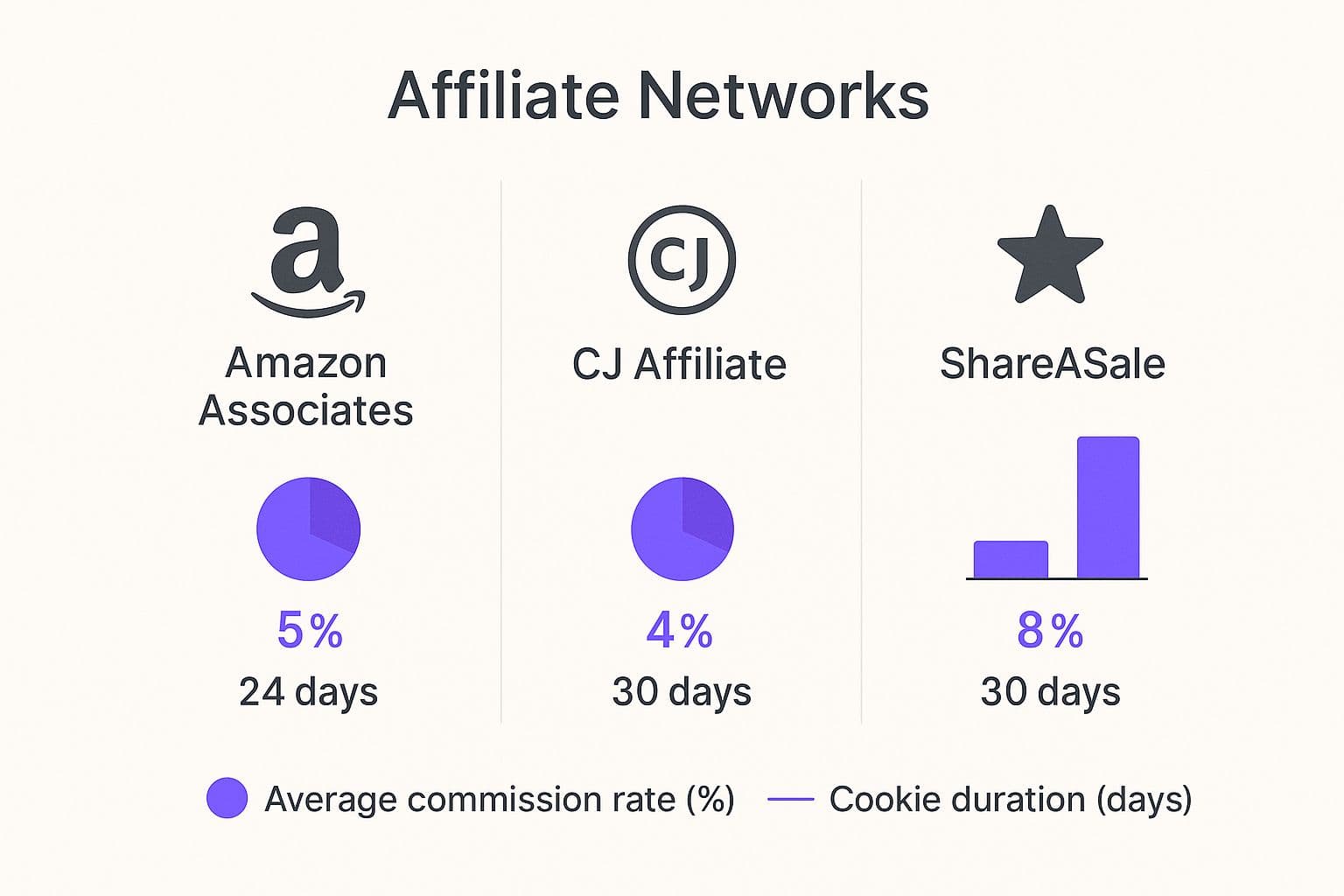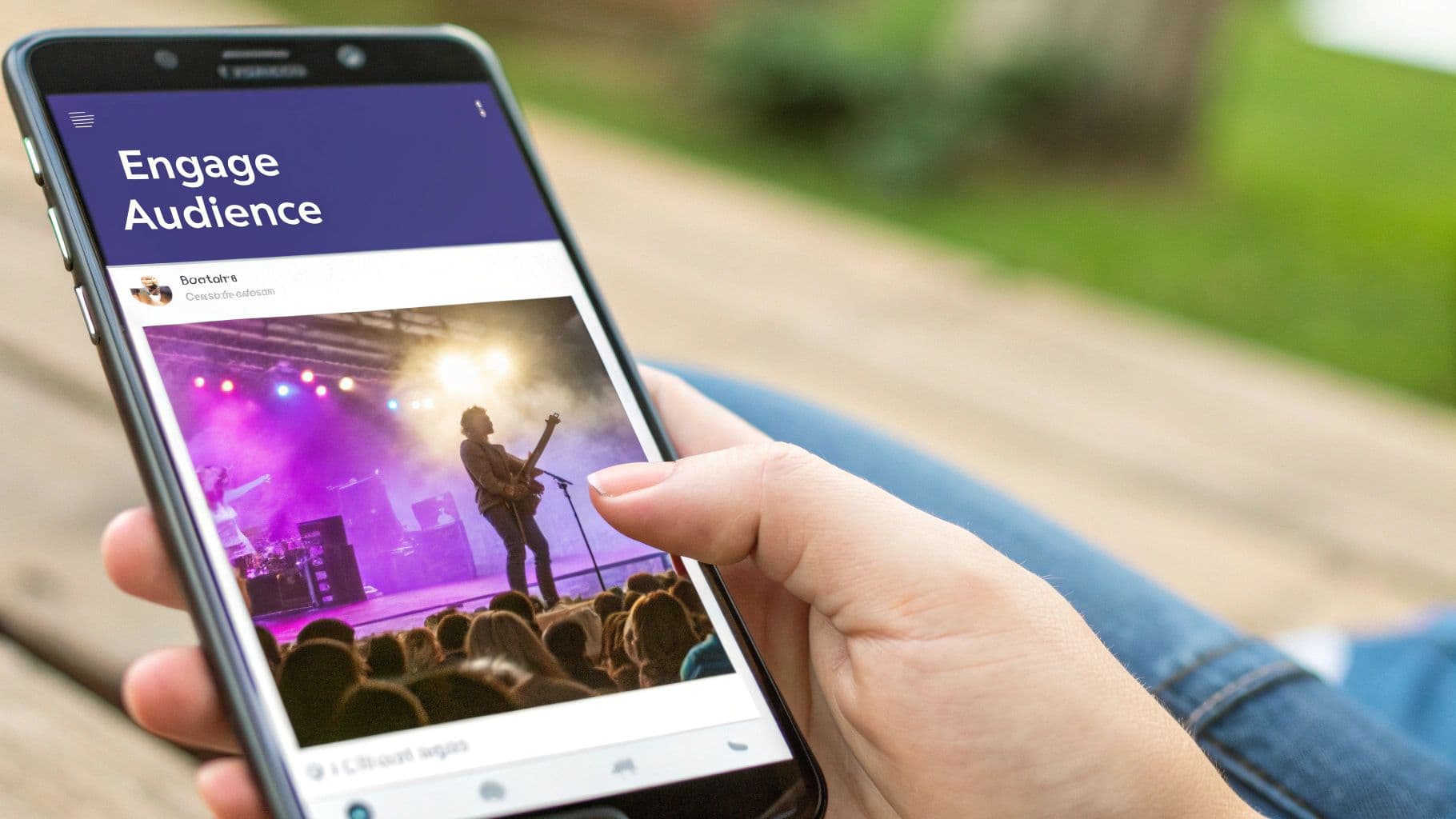Affiliate Marketing on Facebook: A Practical Guide to Success

Affiliate marketing on Facebook is a straightforward process: you earn commissions by promoting products you believe in to a massive audience. To succeed, you must move beyond just posting links. The goal is to strategically integrate your unique affiliate links into valuable content on Facebook Pages, Groups, and paid ads to generate sales. Follow this guide to turn your social presence into a reliable income generator.
Why Facebook Is a Goldmine for Affiliates

While new platforms emerge, Facebook remains a top-tier channel for affiliate marketers. Its massive scale provides billions of potential customers, but the real advantage lies in user behavior.
Unlike search engines where users have existing intent, people on Facebook are in discovery mode. This creates an opportunity to introduce products to audiences who aren't actively shopping. Your job is to turn their casual scrolling into genuine interest and, ultimately, a sale.
Actionable Step: Leverage Targeted Reach
Facebook's ad platform is powerful because of its granular audience targeting. You can zero in on people based on their interests, online behaviors, life events, and much more.
Here's how to apply this: if you're promoting a new vegan protein powder, don't just target "vegans." Build a layered audience by targeting users who:
- Follow specific plant-based influencers.
- Are members of vegan recipe Groups.
- Have recently purchased fitness gear or interacted with gym pages.
This level of precision is what transforms a generic campaign into a highly profitable one.
The most actionable advantage of Facebook is its ability to build communities. Launch a Facebook Group around your niche. It becomes your most valuable asset, giving you a direct line to a loyal audience that trusts your recommendations.
Actionable Step: Choose the Right Content Format
To succeed with affiliate marketing on Facebook, you must use the right format for the right message. Don't just post links; create engaging content.
- For Product Reviews: Use high-quality images in standard Facebook Posts on your Page. Write clear, persuasive copy that details the pros and cons.
- For Urgency: Use Facebook Stories to announce flash sales or limited-time bonuses. The disappearing nature of Stories creates immediate FOMO (fear of missing out).
- For Building Trust: Create a Facebook Group. Start conversations by asking questions, post polls, and offer exclusive value. Only recommend products that directly solve problems discussed in the group.
- For High Engagement: Host a Live Video to do a product demo or a Q&A session. This format builds rapport faster than any other and allows you to answer objections in real-time.
The global affiliate marketing industry is projected to hit around $37.3 billion in 2025. By mastering these content formats, you position yourself to capture a piece of this massive market.
Laying a Profitable Foundation
Before launching your first ad, you must build the proper assets. Many affiliates skip this, leading to disabled ad accounts and failed campaigns. Your goal is to build a sustainable system that looks professional, builds trust, and adheres to Facebook's rules.
Start by selecting the right affiliate offers. Look for products with strong social proof, high-quality visuals, and a clear value proposition. The best offers for Facebook solve a specific, nagging problem for a well-defined audience.
Actionable Step: Choose the Right Affiliate Network
Your choice of affiliate network is critical. Each has different commission rates, product categories, and rules for social media promotion. Some are far more flexible than others.
Use the image below to compare networks based on your needs.

For example, if you're promoting high-ticket items, a network like ShareASale with a longer cookie duration (e.g., 60 days) is better than Amazon, which has a 24-hour cookie. This gives your audience more time to decide, increasing your chances of earning a commission.
Actionable Step: Build Your Core Assets
Directly linking to affiliate offers in Facebook ads is forbidden and will get your account shut down. You must build two core assets first.
- Build a High-Converting Landing Page: This is a simple, one-page website acting as a bridge between your ad and the offer. Its sole purpose is to pre-sell the visitor and get them to click your affiliate link. To make it effective: keep the design clean, use benefit-driven headlines, and feature a single, clear call-to-action button.
- Create a Dedicated Facebook Page: Your ads must run from a Facebook Business Page. Make it look legitimate with a professional profile picture, a relevant cover photo, and at least 5-10 posts related to your niche. You don't need a large following; it just needs to look active and credible.
To stay organized, start using a social media calendar template from day one. It will help you plan your content and maintain a consistent presence.
Key Takeaway: Your landing page and Facebook Page are non-negotiable. They are your digital storefronts that must be professional and compliant to earn the trust of both Facebook's ad reviewers and your potential customers.
The U.S. affiliate marketing industry is projected to reach nearly $12 billion in spending by 2025. With over 70% of affiliate marketers using Facebook, getting this foundational setup right is essential to claiming your share.
This groundwork is the only way to build a profitable and resilient affiliate business on Facebook.
And for brands looking to recruit affiliates, our guide shows you how to set up your own program: How to Start an Affiliate Program That Drives Growth.
Crafting Affiliate Ads That Actually Stop the Scroll

A profitable affiliate campaign comes down to one thing: an ad that grabs attention. You have about two seconds to stop someone from scrolling past.
Successful affiliate marketing on Facebook is a repeatable process of matching compelling creative with precise targeting. It starts with identifying your ideal customer.
Actionable Step: Pinpoint Your Ideal Customer
Before writing a single word of ad copy, build a detailed audience profile. Use Facebook’s Ads Manager to move beyond guesswork. The key is to layer your targeting.
Start with interest targeting. For a high-protein, plant-based meal service, you would target interests like "Veganism," "Plant-based diet," and "CrossFit." Then, apply layers for maximum impact.
Here's how to scale your targeting:
- Create Custom Audiences: Upload your email list or use Facebook Pixel data from your landing page to retarget people who have already shown interest. These warm leads convert at a much higher rate.
- Build Lookalike Audiences: Tell Facebook to find new people who share characteristics with your best customers (e.g., your email subscribers). Start with a 1% Lookalike Audience, as it targets users who are most similar to your source audience, giving you the highest probability of conversion.
Actionable Step: Write Ad Copy That Solves a Problem
Effective ad copy doesn't list features; it connects with a reader's problem and presents your product as the solution.
Use this proven three-part structure:
- The Hook: Start with a question or a bold statement that identifies their pain point. For a sleep aid, open with, "Still counting sheep at 2 AM?" This immediately grabs the attention of your target audience.
- The Agitation: Briefly expand on the frustration. "Tossing and turning only makes you more anxious about the big day you have tomorrow."
- The Solution: Introduce your affiliate product as the hero and finish with a strong, clear call-to-action (CTA). "Click 'Learn More' to see how you can finally get a full night's rest."
Pro Tip: Write your ad copy as if you're explaining the product to a friend. Avoid jargon and exaggerated claims. Authenticity resonates with users and keeps you in compliance with Facebook's ad policies.
Actionable Step: Create Simple, Effective Visuals
Your ad's image or video is what stops the scroll. It doesn't need to be a high-budget production. Overly polished ads often look like ads and are ignored.
Here are three visual styles that work for affiliate offers:
- User-Generated Content (UGC) Style: Use photos and videos that look like they were taken by a real customer. A simple, well-lit shot of someone using the product in a real-world setting builds instant trust.
- Clean Product Shots: For physical goods, use a high-quality image of the product on a simple, contrasting background. This clarity can cut through a cluttered newsfeed.
- Short, Punchy Videos: Create a 15-30 second video demonstrating the product's primary benefit. Add text overlays to explain key points, as most users watch videos with the sound off.
Your visual must communicate the product's value in a split second. Combine a compelling visual with precise targeting and problem-solving copy to create a winning ad.
Keeping Your Campaigns Running Strong
Launching your campaign is just the beginning. Profitable affiliate marketing on Facebook requires consistent monitoring and data-driven adjustments. Your primary workspace will now be the Facebook Ads Manager dashboard.
Your mission is to translate numbers into actions. Focus on the metrics that directly impact your bottom line, not vanity metrics.
Actionable Step: Know Which Numbers to Watch
To make profitable decisions, monitor these key performance indicators (KPIs) daily:
- Click-Through Rate (CTR): The percentage of people who clicked your ad after seeing it. A high CTR (above 1.5%) indicates your creative and copy are resonating.
- Cost Per Click (CPC): What you pay for each click. Your CPC must be low enough to leave room for profit after a sale.
- Return On Ad Spend (ROAS): The most important metric. It measures the revenue generated for every dollar spent. A ROAS above 1.0 means you are profitable.
A common mistake is killing an ad with a high CPC too early. If that ad also has a high conversion rate on your landing page, the higher CPC may be justified. Always analyze metrics in context before making a decision.
Facebook ads are effective for affiliates. Lead generation campaigns average a 2.53% CTR, while traffic campaigns average 1.57%. With an average CPC of just $0.77 and a strong average conversion rate of 8.78%, the platform offers a powerful formula for driving sales. You can find more data in this report on Facebook stats for marketers.
Actionable Step: A Simple System for A/B Testing
Optimization means testing. Use a methodical A/B testing process to find what works without wasting money. Test the biggest variables first: audience and creative.
Here’s a practical testing structure:
- Create one campaign with two different ad sets.
- Ad Set A: Target a Lookalike Audience built from your customer list.
- Ad Set B: Target an interest-based audience (e.g., followers of a key influencer in your niche).
- Run the exact same 2-3 ads in both ad sets.
- Let the campaign run for 48-72 hours to collect sufficient data.
After this period, analyze which ad set delivered a higher CTR and lower CPC. Pause the losing ad set. Now, you have a winning audience. Your next step is to test new ad creatives within that proven audience. This data-driven approach is how you systematically improve ROAS and scale your affiliate business.
Advanced Tactics and Costly Mistakes to Avoid

Once your campaigns are profitable, it's time to implement advanced strategies and avoid common pitfalls that derail progress. The most powerful tool for this is the Facebook Pixel.
Installing the Pixel on your landing page is non-negotiable for serious advertisers. This code snippet tracks every visitor and their actions, feeding that data back into Ads Manager to enable smarter targeting and retargeting.
Actionable Step: Harness the Power of Retargeting
Retargeting gives you a second chance with interested prospects. When someone clicks your ad and visits your landing page but doesn't buy, the Pixel tracks them.
Here's how to set up a retargeting campaign:
- Create a Custom Audience of people who visited your landing page in the past 30 days but did not reach the confirmation page (i.e., did not convert).
- Launch a new ad campaign targeting only this audience.
- Use a different ad angle. Address a common objection, show a customer testimonial, or offer a small bonus to encourage them to complete their purchase.
These people are already familiar with your offer, so retargeting ads almost always yield higher conversion rates and a better ROAS than ads targeting cold traffic.
Successful affiliates know the first click is just the start of the conversation. Use retargeting to continue that conversation with your most engaged prospects and convert them into buyers.
Three Mistakes That Will Wreck Your Progress
Avoid these critical mistakes to build a sustainable affiliate marketing business on Facebook.
-
Direct Linking to Offers: Never run an ad that sends traffic directly to an affiliate sales page. This is the fastest way to get your ad account permanently disabled. Always use your own compliant landing page as a bridge.
-
Using Hype-Filled or Misleading Ad Copy: Avoid exaggerated claims like "make $5,000 this week" or aggressive, clickbait language. Facebook's ad review system will flag it, and users will ignore it. Focus on the product's genuine benefits.
-
Ignoring Ad Policy: Take 30 minutes to read Facebook's Advertising Policies. Understanding the rules is the single best way to protect your ad account from being flagged or banned.
If you are a brand managing affiliates, you must set clear guidelines. Our guide on how to create an affiliate program that drives growth explains how to do this. By teaching your partners to avoid these errors, you protect your brand and build a foundation for scalable success.
Frequently Asked Questions
Here are direct answers to the most common questions about affiliate marketing on Facebook.
Can I Just Post Affiliate Links Directly on Facebook?
No. While you technically can, you absolutely should not. Direct linking in posts or ads is a fast track to getting your content flagged as spam and your account restricted.
The correct and sustainable method is to send all traffic to your own landing page first. This page acts as a professional bridge, allows you to install your Facebook Pixel for retargeting, and ensures compliance with both Facebook's and your affiliate network's policies. Do not skip this step.
What’s a Realistic Starting Budget for Facebook Ads?
A practical starting budget is $15 to $25 per day. This amount is enough to run tests across a couple of different ad sets or creatives simultaneously, which is essential for gathering data quickly.
Treat your initial ad spend as an investment in data, not immediate profit. You are paying to learn what resonates with your audience. Once you find a winning combination of ad and audience, you can confidently increase your budget.
After identifying a profitable ad set, scale your daily budget slowly—by no more than 20% every 48 hours—to maintain campaign stability and maximize returns.
How Do I Keep My Facebook Ad Account From Getting Banned?
Protecting your ad account is your top priority. Follow these rules without exception.
First, read and understand Facebook’s Advertising Policies. Most account bans result from easily avoidable violations.
Here are four actionable rules to follow:
- No Direct Linking. Ever. Always send ad traffic to your own compliant landing page.
- Avoid Hype. Do not make specific income claims or promise unrealistic results. Focus on the product's tangible benefits.
- Include Legal Pages. Ensure your landing page has clearly visible links to a Privacy Policy and an affiliate disclosure statement. This is a requirement for compliance.
- Warm Up New Ad Accounts. Before launching an affiliate campaign from a new account, run a low-budget Page Likes campaign for 5-7 days. This builds a positive history with Facebook's algorithm before you start sending traffic off-platform.
Ready to manage your affiliate partnerships with ease and precision? Push Lap Growth provides a complete platform to recruit, track, and pay your affiliates, all under your own brand. Start your free 14-day trial today.